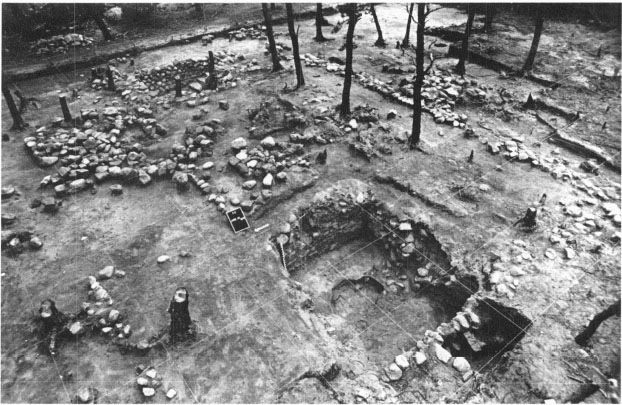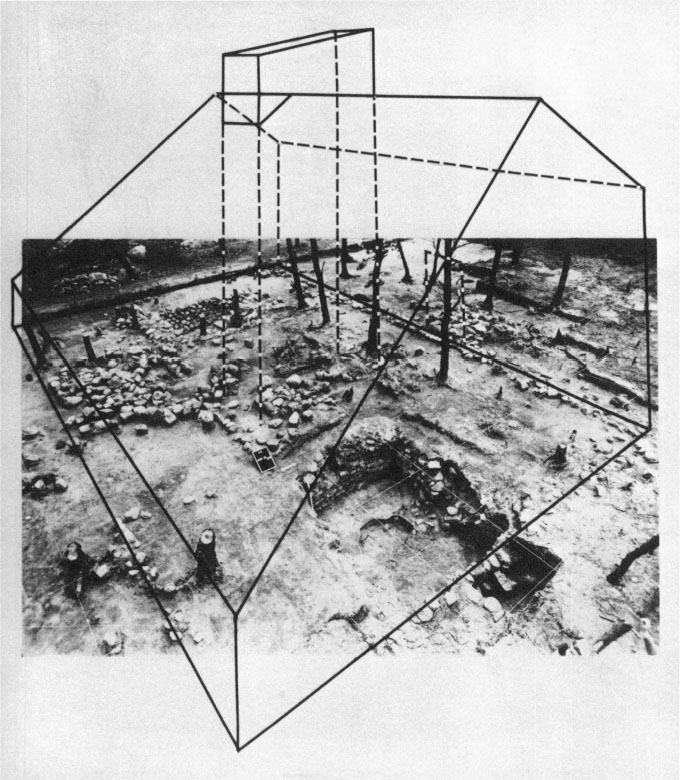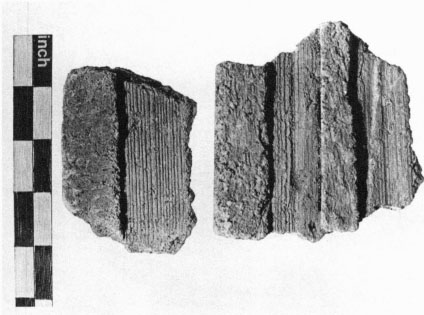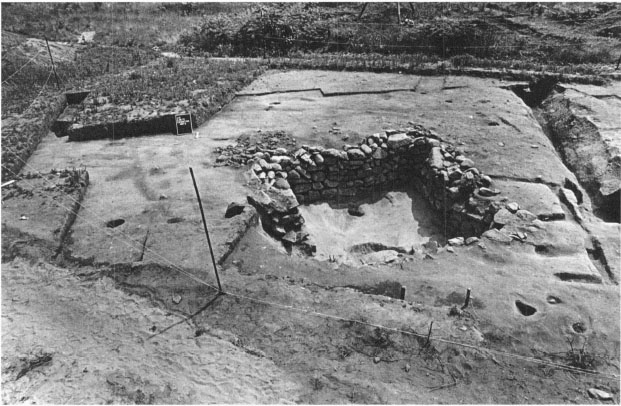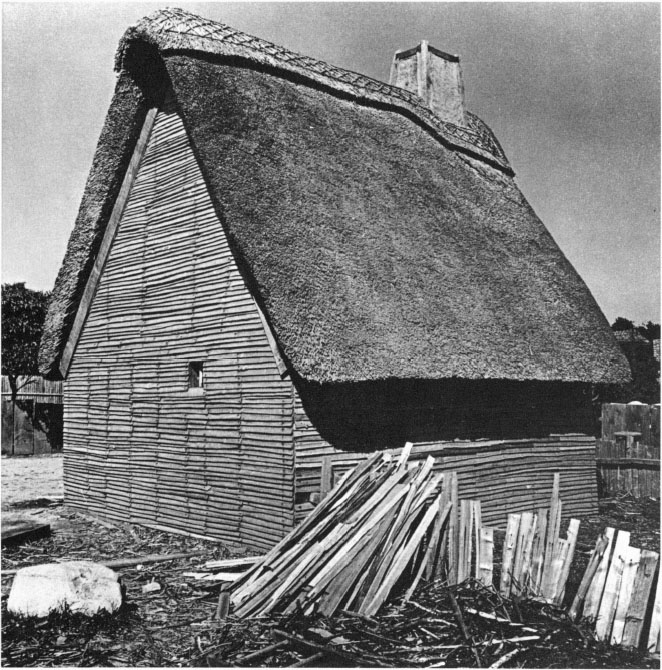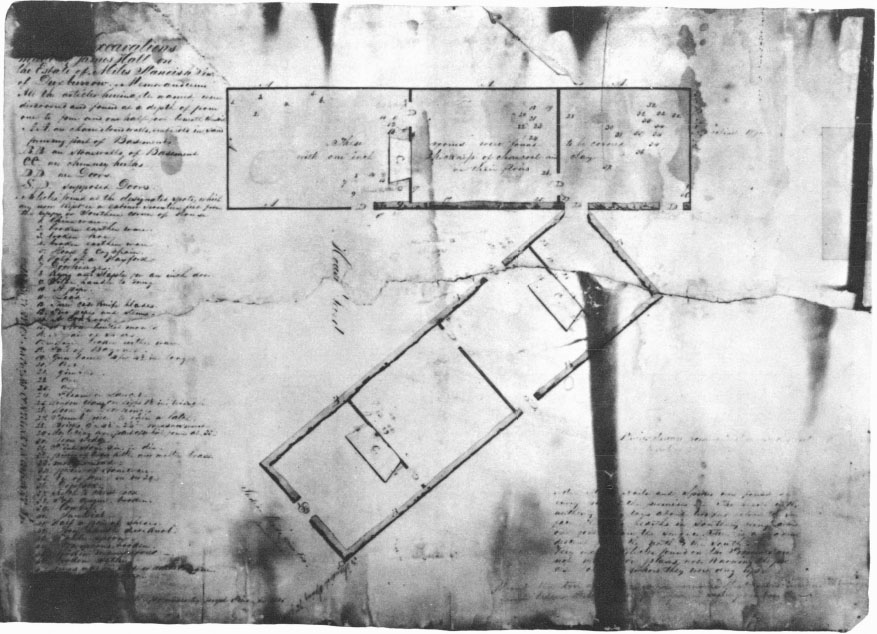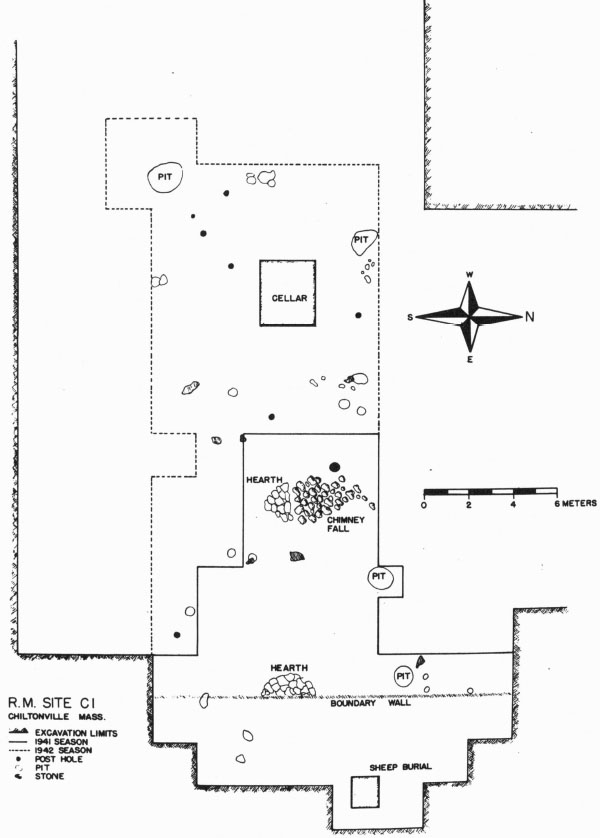Plymouth Colony Architecture: Archaeological Evidence from the Seventeenth Century
THE contribution which archaeology may make to the study of early vernacular structures in New England is of a limited but very special nature. By its very definition archaeology deals only with that part of any building which was either below ground or which would leave evidence within the ground to be recovered and studied by the archaeologist. Such a limitation immediately rules out a major portion of the data normally used by students of early buildings. On the other hand, the archaeological remains of buildings are much more durable and less subject to loss over time as long as the site on which they are located is not disturbed. Furthermore, there is some evidence in the ground for structures earlier than those which have somehow survived the passage of time, and, in the Plymouth area, for buildings quite different from any known on the basis of surviving examples.
There are no standing structures known in the area that was Plymouth Colony which can be confidently dated to the first half of the seventeenth century, and only a few which might be assigned to the third quarter of that century. As a result, study of the earlier building traditions of the Old Colony has always had to rely on documentary evidence of a variety of types, from references to buildings or parts of them in the court records to a rich body of probate data which at least gives a feeling for the number and uses of rooms in these early dwelling houses. Within the past twenty-five years, an increasing interest in the archaeological study of Plymouth Colony has resulted in the excavation of some twenty-odd sites, some of which have produced architectural data of a limited but unique nature. This paper will examine these data and demonstrate how they shed additional light on the story of architectural development in the Old Colony and raise new questions.
The precise form of archaeological evidence of an architectural nature can be thought of in terms of both its focus and its visibility. By focus is meant the degree to which archaeological features can be read clearly and unambiguously. The visibility of an archaeological feature is primarily a function of the quantity of material which is observed. Some examples will make these concepts clear. A house which was occupied briefly and had no later modifications might leave a set of footings, chimney base, and cellars to be excavated by the archaeologist. Such a feature has clear focus as well as high visibility. On the other hand, if the structure had no cellars, and footings which were set on the ground and later removed, its visibility would be much less to the archaeologist, consisting only of a chimney base as an archaeological feature. Houses which underwent successive builds, with walls cutting walls, might have a very high visibility, but the focus of the feature would be quite low, having been affected by later developments. Factors which affect both focus and visibility fall into three broad classes; duration of occupation, manner of destruction or removal, and type of construction. Generally speaking, longer occupations lead to higher visibility and poorer focus. Houses which burned in place have sharper archaeological focus than those which were moved or dismantled. Construction which intrudes below grade enhances both focus and visibility. The ideal feature for archaeological study would be a house which was built with wall trenches, deep chimney base, and cellars, was occupied for a relatively brief time, and was not added to in any way, and which burned in place. The least useful type of feature would be the remains of a house which was occupied briefly, had no cellars or other below-ground features, and was systematically dismantled in situ, with all of its building materials carted off for reuse elsewhere. Sites of both extreme types and intermediate forms have been excavated in the Plymouth Colony area.
From an architectural standpoint, the two most significant sites to have been excavated in the Old Colony are a whaler’s tavern located on Great Island, Wellfleet, Massachusetts (Ekholm and Deetz, 1971), and the Isaac Allerton dwelling house in Kingston, Massachusetts. One is of late seventeenth-century date and of specialized function, the other is the earliest single source of archaeological architectural information thus far studied from Plymouth.
The whaler’s tavern on Great Island was excavated by a Plimoth Plantation archaeological party during the summers of 1969 and 1970. In terms of both focus and visibility this site is the most productive yet to be studied. While its period of use coincides in part with a time from which we have standing structures elsewhere in the Plymouth Colony area, the date of initial erection, circa 1690, is quite early for Cape Cod, and thus provides important late seventeenth-century architectural information for that area. The building was definitely abandoned and removed by circa 1735, and there was no later construction of any type on the site. The limiting dates for this site are based on artifactual dating. The pipestem interior bore diameter curve peaks in the period 1710–1750, suggesting that the most intensive occupation of the site took place during the first half of the eighteenth century. Ceramic dates permit a refinement of this date to a considerable degree. The initial date of 1690 is based on the occurrence of both North Devonshire Sgrafitto ware, which occupies a late seventeenth-century date range where it is found elsewhere in the country (Watkins, 1960), and Frechen stoneware in the form of Bellarmine jugs, also a seventeenth-century type. Further support to a 1690 beginning date is provided by late seventeenth-century wine glass stems and seal-top spoons with fig-shaped bowls. A termination date of circa 1735 is based on somewhat less secure data, but the total absence of white Staffordshire stonewares and the prevalence of the dipped stonewares from the same region argue strongly for such a date (Mountford, 1971).
The tavern was a large structure, fifty feet in length and thirty feet in width (Fig. 9). The front entrance was central and faced south. A roughly paved walkway led to the door. Both the focus and visibility of this structure were excellent, primarily because Great Island, being a vast sand dune, has no stones occurring naturally. Thus all stone encountered archaeologically could safely be assumed to have been brought in for construction. The chimney had been of brick; only the base survived, and it was located in the traditional position in the center of the building with the door coming in just opposite the chimney breast. Large quantities of brick were found in one of the cellars and scattered over much of the site. A tentative ground plan for this building would indicate two large rooms flanking the chimney, with at least one other room to the rear beneath some type of lean-to (Fig. 10). It is impossible to determine whether the building had been of one or two stories. A two-story arrangement is suggested by the function it clearly served, that of a tavern for shore whalers working from the Great Island beaches. Each of the main front rooms had a cellar beneath its floor. That beneath the east room was small (8′ x 10′) and lined with rounded beach cobbles set with sand-and-clamshell mortar. It was entered by way of a set of stone stairs from within the house, presumably through a trapdoor in the floor. Its low height, under five feet, suggests that it functioned as a food storage cellar. A remarkable artifact found on the floor of this cellar was probably connected with food processing: a large cervical vertebra of a whale made into a chopping block, possibly for meat. The cellar beneath the west room was larger (9′ x 10′) and slightly deeper. At one time it had been entered through a bulkhead from the west exterior side of the building, but by the time of abandonment this entrance had been walled up and entrance must have been through a floor trapdoor, as in the east cellar. The west cellar was also lined with a very different kind of stone, flat rectangular pieces laid in rather even courses. This cellar was also probably primarily for food storage.
Numerous architectural details were provided by artifacts recovered in and around the foundation and its cellars. Window glass fragments numbered in the thousands, and sufficient pieces of lead cames were recovered to indicate diamond-paned windows. Nails were even more numerous than glass shards.
Interior wall plaster was also abundant. This material provided some specific information on the framing and sheathing of the house. Almost every one of the thousands of pieces of wall plaster bears an impression of the wall to which it once was attached (Fig. 11). Impressions of laths are very clear, showing the grain of the wood and the placement of lathing nails. These impressions in every case demonstrate that the laths were attached to vertical planks rather than to studs. The grain of the planks shows clearly, confirming the possibility of exterior vertical plank siding rather than stud construction. Had the laths been attached to studs, the plaster would have compressed between them and encountered no surface behind them. The resulting impression in such a situation would show no form or impressions between the lath impressions such as occur on the examples in question. If the tavern was sheathed in this fashion, it would stand as a good early example of this style, which Candee (1969) has suggested to be a Plymouth Colony diagnostic, and the easternmost occurrence of the technique.
The ultimate fate of the Wellfleet tavern is unknown. Local traditions hold that it was floated across the harbor and erected somewhere in the town of Wellfleet. This possibility has not yet been proven to be true, but it is certain that the building was removed, whole or in parts, rather than burned. No evidence was found suggesting a fire. On the other hand, the large quantity of nails, bricks, and plaster fragments strongly suggests at least a partial dismantling of the structure, if not a complete razing. However it met its end on that site, there was no other construction or occupation on the location for the following two centuries. The only artifacts found which did not relate to the occupation period cited above were the casual leavings, such as whiskey bottles, of people who had dug randomly in the ruin in this century in search of coins or bottles.
Archaeological remains of Plymouth Colony’s earliest dwelling houses are extremely scarce. It is now certain that the main reason for this rarity is that such buildings were of a sort which resulted in archaeological features of very low visibility. Goods were scarce in the Colony’s early years, there was little in the way of disposable refuse, cellars seem to have been rare if nonexistent, and construction techniques were of a type to leave little readable evidence for the archaeologist. Thus it was unusual when, in the summer of 1972, Plimoth Plantation archaeologists found and excavated a house which almost certainly was constructed in 1630, and which had been destroyed by the middle of the seventeenth century. Even the discovery of this site was largely a matter of luck. A Kingston, Massachusetts, man planned to build a house on a vacant parcel of land. By fortunate coincidence, his architect had some knowledge of seventeenth-century artifacts, and finding a few in a freshly plowed garden he brought them to the Plantation for identification. They proved to be of a very early date and subsequent investigation of the plowed area suggested that the remains of some kind of building might be there. An extensive excavation program which occupied most of the summer resulted in the recovery of a ground plan which had very sharp archaeological focus, although the visibility was quite low.
During the 1630’s, the parcel of land was the property of Isaac Allerton, one of the Colony’s financial agents. It is known that Allerton had moved to Kingston, and presumably built a dwelling house there as early as 1630. The artifacts recovered from the site are totally consistent with such a date. The house was a small structure, twenty by twenty-two feet square, of post-hole-type construction (Fig. 12). Each corner of the house was occupied by a massive post, possibly eighteen inches square, set four feet into the ground. These posts carried plates and girts, and probably studs which in turn supported wattle and daub walls. Any evidence of these studs was unrecoverable, since they were usually not set deeply into the ground, and years of cultivation had thoroughly disturbed the upper foot of the site. A rectangular hearth occupied one end of the house, laid directly on the ground, and made from cobbles set without mortar. This hearth measured seven feet by slightly more than three. It showed evidence of intensive use, the stones being thoroughly blackened and fire cracked.
Parallel to the house at the end opposite the hearth ran a palisade, probably of contiguous poles some eight feet high. The palisade began at the house and ran some three hundred feet to the south, at which point it simply stopped. Since the palisade did not enclose anything, it almost certainly was never finished. The reason for this is not known, nor will it ever be; one can surmise that perhaps the need for which it was being built no longer existed before it was complete, or that Allerton tired of the project before finishing it. At regular intervals along the palisade, faint evidence of other structures was found. These were presumably outbuildings. Support for this identification comes mainly from artifacts found in the palisade trench adjacent to each location. It is fairly certain that sometime around 1650, the dwelling house and outbuildings were torn down, as was the partially completed palisade. The palisade must have been dismantled first, since at regular intervals the open trench was filled with structural debris and artifacts. Only that part of the palisade trench adjacent to the dwelling house contained a full domestic assemblage, with a variety of ceramics, food refuse, smoking pipes, glass, and tools. One of the concentrations consisted almost solely of redwares and may relate to a dairy adjacent to the palisade at that point. Time and construction schedules did not permit the full investigation of all of these loci. The testing that was done on them strongly suggested special functions for the other buildings.
The dating of this earliest construction period is supported by pipestem data, preponderantly of the period 1620–1650, and ceramics, which included Cologne stonewares typical of the early years of the century, white sandy wares, also common at that time but absent in the second half of the century, and small amounts of the more elaborate blue on gray Westerwald wares of the same period. A seal-top spoon with the short seal most common from the late sixteenth and early seventeenth centuries and a coin and lead fur-bale seal from the reign of King James I also support the assigned dates.
Sometime later, probably in the third quarter of the seventeenth century but possibly at the same time as the first complex was destroyed, a second more elaborate house was constructed on the same site. This structure was represented archaeologically only by a cellar twelve feet square with dry laid stone walls and a sand floor. This low visibility probably resulted from subsequent destruction of this house and the disposition of the footing stones in the cellar. Some twenty-five tons of stone were removed from the cellar when it was excavated. No chimney base could be located; it may have been removed in the course of the construction of the modern house now occupying the site. This second house was removed from the site circa 1725, a date based on artifacts found in the cellar fill. No later occupations occurred on the site until the construction of 1972. The cellar belonging to the second house cut the corner of the hearth of the first, providing a clear sequence for the two buildings.
The earlier component of the Allerton site is very important since it is the only direct evidence for post-hole construction in Plymouth Colony. In his history of the Plantation, William Bradford suggests such a construction type in his description of the hurricane of 1635: “It took off the boarded roof of a house which belonged to this Plantation at Manomet, and floated it to another place, the posts still standing in the ground” (Morison, 1952).
If the post-hole-type house was a common form in early Plymouth and these houses were constructed, as was the Allerton house, without cellars, it is little wonder that locating such early sites is so difficult. Both the visibility and focus of sites of this type are of such a low order on the surface that they must be discovered by chance. Removal of the topsoil enhances the picture, but in view of the paucity of artifacts and refuse in this early period they are difficult to detect from the surface.
The excavations at the Allerton site formed the basis for the recreation of an early post-hole-type house at Plimoth Plantation in the summer of 1973. Using only traditional tools, techniques, and materials, Professor Henry Glassie, a folklorist at the University of Indiana, designed and directed the construction of this building. It probably bears a close resemblance to the house which Allerton built in Kingston in 1630 (Fig. 13).
The existence of the post-hole-type house in Plymouth Colony has been demonstrated by archaeological excavation and analysis. Yet another house type, also not represented in the surviving structures of the Old Colony and possibly as early as the post-hole type, is strongly suggested by two excavations, one done in the nineteenth century on the Miles Standish homesite in Duxbury, and the other done in 1960 on John Alden’s first Duxbury house. The Standish excavation is truly remarkable. Done by James Hall in the 1860’s, it stands as the earliest known example of controlled archaeological excavation done anywhere in the world (Fig. 14). Hall’s work stands as a model to this day; careful notes, the establishment of a control datum point, and proper cataloguing of artifacts all attest to a careful worker. The site map and the remnants of the artifact collection are today the property of the Pilgrim Society, Plymouth, Massachusetts. Hall uncovered a long structure represented by both wood and stone footings, with a cellar at one end. The building measures sixty by fifteen feet, a length-breadth ratio of 4:1. On the basis of the artifacts which have survived, this house was probably built by Standish at the same time that Allerton was newly living in Kingston. Roland Robbins’ work at the Alden site, also in Duxbury, produced a remarkably similar ground plan (Fig. 15). In this instance, the house was shorter (forty feet) and narrower (ten feet) but also had an end cellar, and the length-breadth ratio is identical. Such long, narrow structures are not known from later surviving Plymouth examples. Just what English antecedents relate to them is unclear, although some of the buildings at Jamestown, from a somewhat later date, are similarly elongated. The R.M. site in Plymouth, Massachusetts, excavated by Henry Hornblower in 1940, is that of a house which was occupied for perhaps as long as forty years (1635–1675); as a result, the focus of the features excavated is of a low order. Further complications at this site resulted from intensive plowing of the site over a long period and large quantities of natural stone in the area. Yet when one examines the relationship between the cellar and a pair of hearths which were exposed, a long, narrow ground plan best accommodates these features (Fig. 16). It is not possible to make any definitive statements concerning these somewhat ambiguous examples, except to note that along with the Allerton site they suggest at least two different building traditions of early Plymouth, both different from those which a study of later examples would suggest. It is noteworthy that Abbott Cummings has suggested a date of circa 1660 as the end of the earliest phase of New England building. Such a date provides time for a single generation to have come of age in New England, and thus for the beginnings of an indigenous American cultural configuration. This same date has been suggested as marking the end of an initial English period of development of material cultural pattern and use as seen in ceramics (Deetz, 1973). It is reasonable to argue that for the first generation, newly arrived English immigrants would have built in a variety of styles which reflected their English regional origins. After circa 1660, this variation would have been sharply reduced, with one modal style of building emerging as characteristic of the new “home-grown” American Colonial tradition of the later seventeenth and early eighteenth centuries. Thus it is that the later part of the “first period” of New England building shows a greater architectural homogeneity than that which may well have prevailed in the initial years of the settlement of New England. The Plymouth data, limited as they are, strongly suggest such a model of development and change.
All of the data outlined above are reasonably firm and clear. It is important to note that there are many other sites which have been excavated which have provided little of significant architectural importance. All too often, one can locate cellar and chimney base, but evidence for footings and locations of walls is sadly lacking or so obscured by natural stone in the New England soil that a clear ground plan is impossible to determine.
The most frustrating site encountered by Plimoth Plantation archaeologists was that of Edward Winslow’s first house in Marshfield, Massachusetts. That it was an early site was certain. Its existence, like that of the Allerton site, was known from random artifacts coming from a vegetable garden. Six weeks of hard and careful work produced enough artifacts to hold in two hands and a red smear of decomposed brick which presumably marked the base of the chimney. Beyond these tantalizing bits of evidence, there was nothing. It is very likely that the house which once stood on the site was systematically disassembled for materials, leaving almost nothing behind. The Winslows built a much more elaborate house just adjacent to this first one, and excavation on this site produced a very rich collection dating to the second half of the seventeenth century.
Archaeology, then, is not a consistently rewarding source of architectural data on seventeenth-century vernacular building. For every Allerton dig there are ten which produce a muddled maze of disturbed stones, brickbats, and partially preserved cellars. Yet in view of the fact that it requires but one site such as that of the Allerton house to produce truly new and unique data for the Colony’s earliest houses, work will continue, and new insights are bound to come, albeit slowly.
BIBLIOGRAPHY
Richard Candee, “A Documentary History of Plymouth Colony Architecture 1620–1700,” Old-Time New England, Vol. 60, No. 2, 1969.
James Deetz, “Ceramics from Plymouth, 1635–1835: The Archaeological Evidence,” Ceramics in America (Winterthur Conference Report 1972, University Press of Virginia for Winterthur Museum, 1973).
Erik Ekhom and James Deetz, “Wellfleet Tavern,” Natural History, Vol. 80, No. 7 (August–September 1971).
Samuel E. Morison, ed., Of Plymouth Plantation (New York, 1970).
Arnold Mountford, The Illustrated Guide to Staffordshire Salt-Glaze Stone-Ware (New York, 1971).
Malcolm Watkins, “North Devon Pottery and its Export to America in the Seventeenth Century,” Contributions from the Museum of History & Technology (U.S. National Museum Bulletin 225, Smithsonian Institution, Washington, D.C., 1960).

 JAMES DEETZ
JAMES DEETZ 
